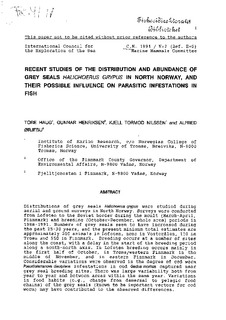Recent studies of the distribution and abundance of grey seals (Halichoerus grypus) in north Norway, and their possible influence on parasitic infestations in fish
Working paper
Permanent lenke
http://hdl.handle.net/11250/104934Utgivelsesdato
1991Metadata
Vis full innførselSamlinger
Originalversjon
This report is not to be cited without prior reference to the authorsSammendrag
Distributions of grey seals Halichoerus grypus were studied during
aerial and ground surveys in North Norway. Surveys were conducted
from Lofoten to the Soviet border during the moult (March-April,
Finnmark) and breeding (October-December, whole area) periods in
1988-1991. Numbers of grey seals seem to have increased during
the past 25-30 years, and the present minimum total estimates are
approximately 200 animals in Lofoten, none in Vesterålen, 110 in
Troms and 550 in Finnmark. Breeding occurs at a number of sites
along the coast, with a delay in the start of the breeding period
along a south-north axis. In Lofoten breeding occurs mainly in
the first half of October, in Troms/western Finnmark in the
middle of November, and in eastern Finnmark in December.
Considerable variations were observed in the degree of cod worm
Pseudoterranova decipiens infestations in cod Gadus morhua captured near
grey seal breeding sites. There was large variability both from
year to year and between areas within the same year. Variations
in food habits (e.g., change from demersal to pelagic food
chains) of the grey seals (known to be important vectors for cod
worm) may have contributed to the observed differences.
